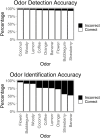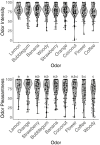Effects of genetics on odor perception: Can a quick smell test effectively screen everyone?
- PMID: 38877790
- PMCID: PMC11519045
- DOI: 10.1093/chemse/bjae025
Effects of genetics on odor perception: Can a quick smell test effectively screen everyone?
Abstract
SCENTinel, a rapid smell test designed to screen for olfactory disorders, including anosmia (no ability to smell an odor) and parosmia (distorted sense of smell), measures 4 components of olfactory function: detection, intensity, identification, and pleasantness. Each test card contains one of 9 odorant mixtures. Some people born with genetic insensitivities to specific odorants (i.e. specific anosmia) may fail the test if they cannot smell an odorant but otherwise have a normal sense of smell. However, using odorant mixtures has largely been found to prevent this from happening. To better understand whether genetic differences affect SCENTinel test results, we asked genetically informative adult participants (twins or triplets, N = 630; singletons, N = 370) to complete the SCENTinel test. A subset of twins (n = 304) also provided a saliva sample for genotyping. We examined data for differences between the 9 possible SCENTinel odors; effects of age, sex, and race on SCENTinel performance, test-retest variability; and heritability using both structured equation modeling and SNP-based statistical methods. None of these strategies provided evidence for specific anosmia for any of the odors, but ratings of pleasantness were, in part, genetically determined (h2 = 0.40) and were nominally associated with alleles of odorant receptors (e.g. OR2T33 and OR1G1; P < 0.001). These results provide evidence that using odorant mixtures protected against effects of specific anosmia for ratings of intensity but that ratings of pleasantness showed effects of inheritance, possibly informed by olfactory receptor genotypes.
Keywords: genetics; heritability; olfaction; pleasantness; reliability; twins.
© The Author(s) 2024. Published by Oxford University Press. All rights reserved. For commercial re-use, please contact reprints@oup.com for reprints and translation rights for reprints. All other permissions can be obtained through our RightsLink service via the Permissions link on the article page on our site—for further information please contact journals.permissions@oup.com.
Conflict of interest statement
On behalf of MEH, VP, PHD, and DRR, the Monell Chemical Senses Center and Temple University have been awarded patent protection (US patent no. 11,337,640), and this patent has been licensed to Ahersla Health, Inc. The authors may benefit financially through their institution’s patent policy. SRH, CL, HN, KB, AH, and PVJ declare no conflicts of interest.
Figures





Similar articles
-
Signs and symptoms to determine if a patient presenting in primary care or hospital outpatient settings has COVID-19.Cochrane Database Syst Rev. 2022 May 20;5(5):CD013665. doi: 10.1002/14651858.CD013665.pub3. Cochrane Database Syst Rev. 2022. PMID: 35593186 Free PMC article.
-
Low to moderate genetic influences on the rapid smell test SCENTinel™.medRxiv [Preprint]. 2023 May 21:2023.05.14.23289965. doi: 10.1101/2023.05.14.23289965. medRxiv. 2023. PMID: 37293001 Free PMC article. Preprint.
-
In mice, discrete odors can selectively promote the neurogenesis of sensory neuron subtypes that they stimulate.Elife. 2025 Jun 18;13:RP96152. doi: 10.7554/eLife.96152. Elife. 2025. PMID: 40531183 Free PMC article.
-
Designing novel "Smell-Aids" to improve olfactory function in post COVID-19 era.BMC Med. 2025 Mar 24;23(1):169. doi: 10.1186/s12916-025-03999-y. BMC Med. 2025. PMID: 40128836 Free PMC article.
-
Interventions for the prevention of persistent post-COVID-19 olfactory dysfunction.Cochrane Database Syst Rev. 2022 Sep 5;9(9):CD013877. doi: 10.1002/14651858.CD013877.pub3. Cochrane Database Syst Rev. 2022. PMID: 36063364 Free PMC article.
References
MeSH terms
Grants and funding
LinkOut - more resources
Full Text Sources

